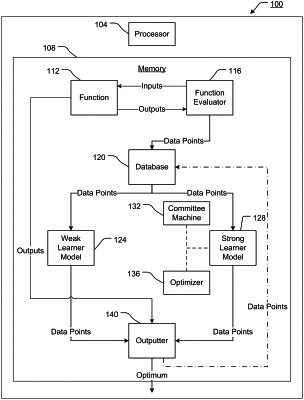| CPC G06N 3/045 (2023.01) [G06F 7/582 (2013.01); G06N 3/08 (2013.01)] | 20 Claims |

|
1. A method for design space optimization, comprising:
generating, by one or more processors, a plurality of first data points by evaluating a function;
training, by the one or more processors, a weak learner model using the plurality of first data points;
training, by the one or more processors, a strong learner model using the plurality of first data points, the strong learner model having a greater measure of fit to the plurality of first data points than the weak learner model;
defining, by one or more processors, a plurality of monitor points within a design space;
in a first iteration, generating, by the one or more processors using the weak learner model, a first count of second data points; generating, by the one or more processors, using the strong learner model, a second count of second data points using an optimizer; and generating, by the one or more processors, a first count of a plurality of output monitor points using the plurality of monitor points and the weak learner model;
in a second iteration, generating, by the one or more processors using the weak learner model, a third count of second data points; generating, by the one or more processors using the strong learner model, a fourth count of second data points using the optimizer; and generating, by the one or more processors, a second count of a plurality of output monitor points using the plurality of monitor points and the weak learner model;
determining, by the one or more processors, a change of the plurality of output monitor points above a predetermined threshold between the first iteration and the second iteration;
in a third iteration, generating by the one or more processors using the weak learner model, a fifth count of second data points, and generating, by the one or more processors using the strong learner model, a sixth count of second data points using the optimizer, wherein the fifth count of second data points and the sixth count of second data points are each determined based on the change of the plurality of output monitor points above the predetermined threshold;
evaluating, by the one or more processors using the function, input values corresponding to the second data points to generate a candidate optimum output; and
outputting, by the one or more processors, the candidate optimum output responsive to an output condition being satisfied.
|